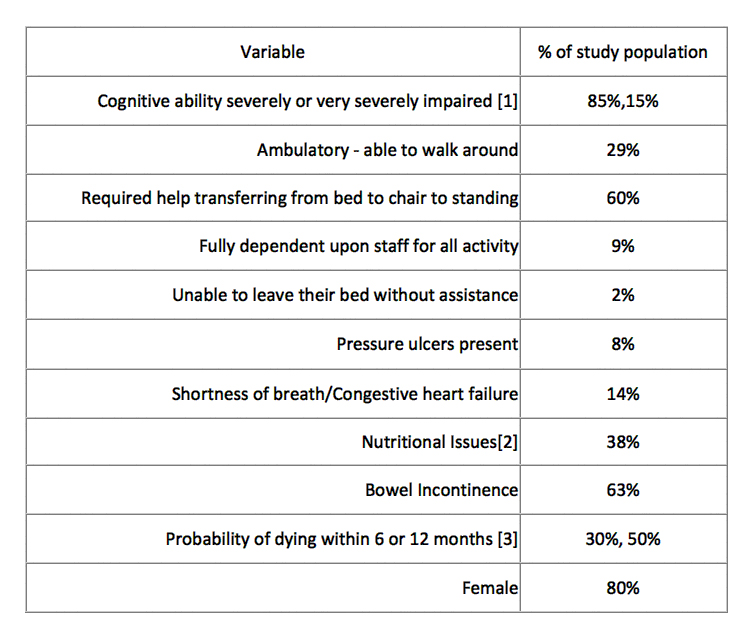It is difficult to make care decisions when you are entrusted by a family member whose dementia is so advanced that it now requires the continuous care of a nursing home. And even with planning, the phone call informing you that they have broken a hip brings a new reality to those choices. Do you have the surgeons repair the fracture or do you treat it with bedrest allowing the fracture to heal for itself? A study from JAMA Internal Medicine concerning our decisions and their subsequent outcomes for all family members has a lot to teach.
The study
The data is retrospective, obtained from what is termed the Minimum Data Set, a comprehensive (400 variable) assessment of nursing home patients done on admission and quarterly after that. The researchers identified 3083 patients who had advanced dementia and had fractured their hip during a two year period- roughly 7% of all hip fractures in nursing home patients. The patient's median age 84.2, About 80% were female. All had advanced dementia described as severely, or very severely impaired cognitive function. 85% underwent surgery; the remaining 15% were managed with bed rest. Both treatments offer pain relief and a stable quality of life. Surgery offers the hope of ambulation.
The crowd's wisdom
The study looks at variables describing these patients ability to walk and underlying conditions that limit ambulation and quality of life. They summarized their findings for the entire group and also looked at the subgroups of non-ambulatory and ambulatory patients. I have summarized and aggregated the whole group in this table.

We can get a sense of what was important to physicians and families in deciding by looking at the differences in these variables between the group undergoing surgery and those treated with non-operatively.
Ninety-five percent of the ambulatory patients and 81% of the non-ambulatory patients underwent surgery. Nutritional deficiency, the inability to leave one’s bed, an inability to transfer oneself and the presence of bedsores all were greater in both those treated non-operatively. In the initially non-ambulatory patients, being entirely dependent upon the staff was another variable found to be greater in the non-operative group. I would summarize the considerations, based upon these variables as trying to both make the patient comfortable and retain some dwindling autonomy. Bowel function and life-expectancy played no role
Damned if you do, damned if you don’t
Dementia and a hip fracture are a lethal combination. Thirty-five percent of these patients were dead within six months, 62% at two-years - consistent with their predicted life expectancies before their fracture. Surgery patients had 3-fold greater survival during the first 30 days after injury and the most prolonged median survival 17 months vs. five months for non-operative care. Surgical patients were twice as likely to be ambulatory at six months, but the absolute number was low only 11 percent. Pain is difficult to assess in the demented but the need for pain medications differed by only 1%, 29% in the surgical group, 30% in the non-operative - this is not clinically significant. Surgery did come with some unintended consequences, these patients were more agitated, requiring more antipsychotic medications and more physical restraints; they also had fewer pressure ulcers. And while none of these factors were “statistically significant” they may well be clinically. Despite the experience of deciding on surgical intervention by these families, they remained reluctant to make any "irrevocable" decisions - 21% utilized hospice and only 1% of either group issued a new directive stopping further hospitalization. fore
Studies have asked the families making decisions, proxies, how best to proceed. Sixty percent choose comfort care even if it reduced life expectancy; seven percent want “everything” done; the rest of us fall somewhere in between. I believe the study provides some guidance.
- The chance of these patients walking again is vanishingly low and must be balanced against the risk of increasing agitation, requiring more antipsychotic medications and restraints - making their dementia worse.
- Surgery prolongs life but the quality will at best stable and may well deteriorate over time.
- Surgery does not reduce pain to a clinically greater degree than non-operative management.
- Non-operative care, the acceptance of rapidly approaching death leaves these patients with a more diminished but stable but short-term quality of life.
- Consideration of hospice care is a big "ask," because it means the family must confront the death of a loved-one in the near term and not in some vague future time-frame.
End of life issues in the here and now are tough, just as they've always been. Discussions, before emotion takes the upper hand, are necessary but not sufficient. Empathy and compassion are entangled in our hopes and fears. This paper provides measures to disentangle them and to give our families a balance of comfort and autonomy.
NOTES:
[1] Measured using the 6-point cognitive performance scale, ranging from borderline intact to very severely impaired.
[2] Eating less than 75% of their meals or a body mass index of less than 18.5 – underweight.
[3] Based on a validated tool, the Advanced Dementia Prognosis Tool (ADEPT)
Source: Association of Clinical Outcomes with surgical repair of hip fracture vs. non-surgical management in nursing home residents with advanced dementia. JAMA Intern Medicine DOI: 10.1001/jamainternmed.2018.0743




